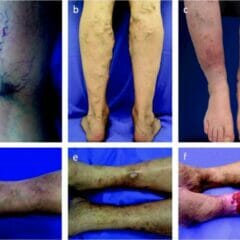Playlist
Show Playlist
Hide Playlist
Venous Diseases: Overview
-
Slides 08 VascularMedicine advanced.pdf
-
Download Lecture Overview
00:01 Welcome back to Vascular Medicine - The Advanced Venues. 00:05 We are going to discuss today venous diseases. We’ve been talking a lot about arterial diseases up to this point. Now we’re going to look at the second component of the cardiovascular system: the venous diseases. 00:18 We’re going to start with a definition of the various kinds of venous diseases. It turns out that, just as in the arterial disease, thrombosis – or the development of a blood clot –can develop in patients in the veins just as they can in the artery. And just as in the artery, pieces of the blood clot can break off and go elsewhere in the circulation and cause mischief. The same thing can happen in the venous system. 00:48 In the venous system, when a blood clot forms and breaks off it goes to the lung and is known as pulmonary embolism. 00:58 What often leads to clot in the veins is an inflammatory process called deep venous thrombosis or DVT. And that inflammation in the wall of the vein – and we’ll talk about the reasons why that can happen – results in a blood clot forming. The blood clot can get bigger and bigger and bigger, pieces can embolize and result in pulmonary embolism. If enough blood clot gets into the lung, you can have enough obstruction of blood flow through the lung that the patient may develop shock – the subject of the last lecture. 01:37 So, often this disease is called venous thromboembolism because there’s clots in the leg and there’s clots embolising to the lung. And that’s often abbreviated as VTE. 01:50 Remember what a thrombus is. A thrombus is a solid mass of platelets and / or fibrin that has formed locally in a vessel. It’s a blood clot. And it forms when the clotting mechanism is activated. 02:07 Thrombosis is actually obstruction of a blood vessel by a thrombus. And, of course, when that happens in the arterial system, nourishing blood fails to get to a blood vessel. In the venous system, that doesn’t happen because we have so many reserve veins. Blood usually goes around the area where there’s a thrombus or thrombosis. However, when pieces break off and embolize to the lung, that causes real trouble. 02:35 The most common form of embolism, much more common than arterial embolism, is venous thromboembolism. 02:43 And the commonest form of venous thromboembolism results from deep venous thrombosis. 02:48 And there’s a whole variety of illnesses that increase people’s risk for developing thrombosis in the veins. For example, long periods of bed rest; or long periods of travel in an aeroplane where you’re seated with your legs down; or cancer increases the clotting ability of the blood and can result in that; pregnancy. A whole variety of conditions can lead to either increased clotting tendency or injury to the vein. For example, a fracture, a trauma can injure the vein and lead to deep venous thrombosis. And, again, a piece of the clot breaks off, goes up to the lung and that can cause lots of trouble. 03:32 Occasionally, for example in some forms of trauma, you can have fat or air that embolizes or even little bits of an atherosclerotic plaque that can embolize. But in fact the vast majority of embolism on the venous side is blood clot. And it’s a blood clot that results from deep venous thrombosis. 03:55 When the embolus lodges downstream, it often lodges in the narrowest area. And so in the lung the thrombus will travel until it finds a small enough blood vessel that it gets stuck and then, of course, it causes obstruction of blood flow through that area of the lung.
About the Lecture
The lecture Venous Diseases: Overview by Joseph Alpert, MD is from the course Venous Diseases.
Included Quiz Questions
Which statement below is incorrect?
- Pulmonary embolism most commonly occurs subsequent to atrial fibrillation
- Deep venous thrombosis occurs commonly in hospitalized patients who undergo surgery
- Pulmonary embolism is a complication of deep venous thrombosis
- Most episodes of deep venous thrombosis occur in the veins of the leg
Which of the following is a better description of the composition of a thrombus?
- Platelets and fibrin
- Inflammatory filtrate
- Calcified mass
- Collection of cholesterol
- Combination of clotting factors
Which of the following is not considered as a type of embolism?
- Calcium
- Fat
- Air
- Thrombus
Which of the following is not known as a risk factor for venous thromboembolism?
- Thalassemia.
- Prolonged bed rest
- Pregnancy
- Long-haul air travel
- Cancer
Which of the following is correctly matched?
- Venous side: DVT
- Venous side: myocardial infarction
- Arterial side: DVT
- Venous side: unstable angina
Customer reviews
5,0 of 5 stars
| 5 Stars |
|
5 |
| 4 Stars |
|
0 |
| 3 Stars |
|
0 |
| 2 Stars |
|
0 |
| 1 Star |
|
0 |





